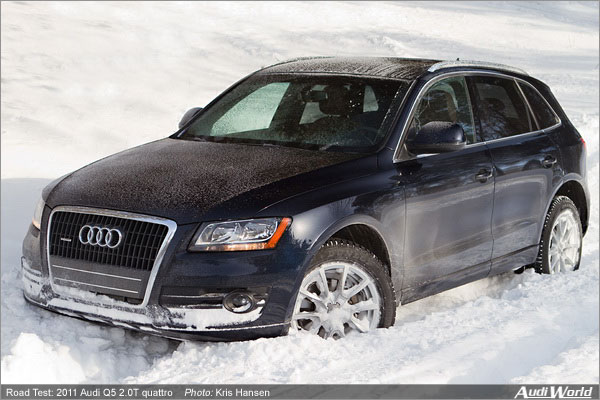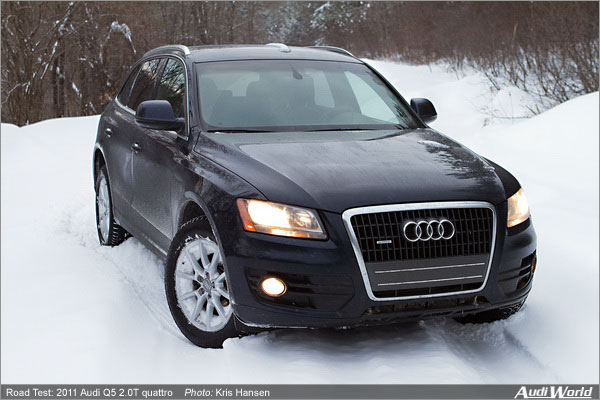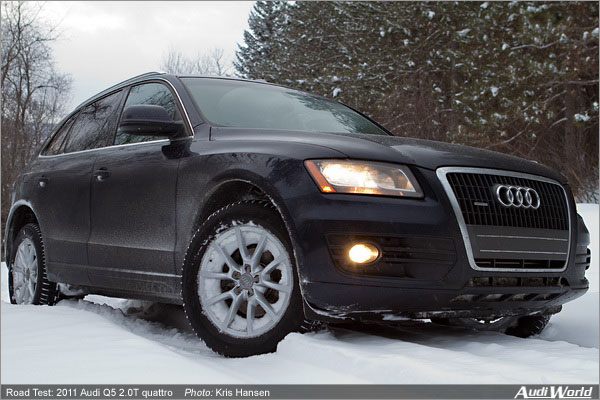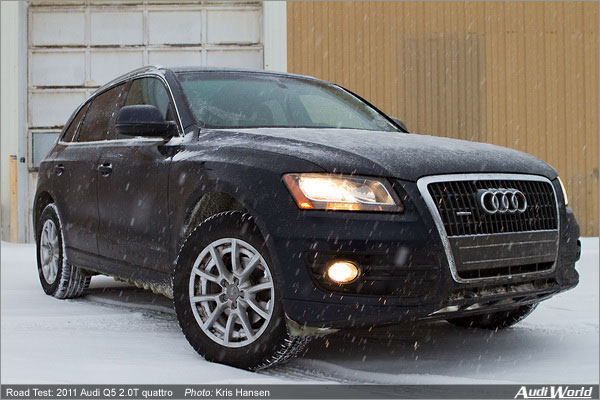Road Test: 2011 Audi Q5 2.0T
In this day of high fuel prices, common sense would dictate that larger and thirstier vehicles wouldnt be in vogue, with buyers instead opting for smaller frugal cars. While that holds true, we also feel that because of our busy lifestyles, and the need to bring people and things places, a larger vehicle is often required. We think we found a happy medium in the Q5 2.0T. As we mentioned in our last test of the Q5 3.2 , the Q5 is an excellently sized car for day to day use, with tons of room for passengers and cargo. Its also very nice to drive, and comfortable on long hauls. The Q5 doesnt mind sporty driving at all either.
Weve always been big fans of Audis turbocharged 4 cylinder engines, and the latest 2.0 liter FSI direct fuel injected version is a sweetheart. In the Q5, its rated at 211hp and 253 lb/ft of torque, which is achieved at 1500 rpm. This small and efficient twin cam 4 valves per cylinder 4 pot engine makes more torque than its larger and thirstier 3.2 liter V6 sibling, which only manages to churn out 243 lb/ft at 3000 rpm.
What that means in day to day driving is much less drama originating from the engine bay. The Q5 accelerates with alacrity, with a nice firm push off the line, as its 8 speed Tiptronic gearbox advances through the tight ratios. When compared to the 3.2 FSI version, the 2.0T Q5 possesses a much more satisfying lower end push, which is appreciated from stop lights, while merging into traffic, climbing hills, and so on. Though the published numbers disagree (Audi says that the 3.2 runs from 0 to 60 in 6.7 seconds, the 2.0 in 7.1), the extra torque from the turbocharged 2.0 makes it feel quicker, at least at lower speeds.
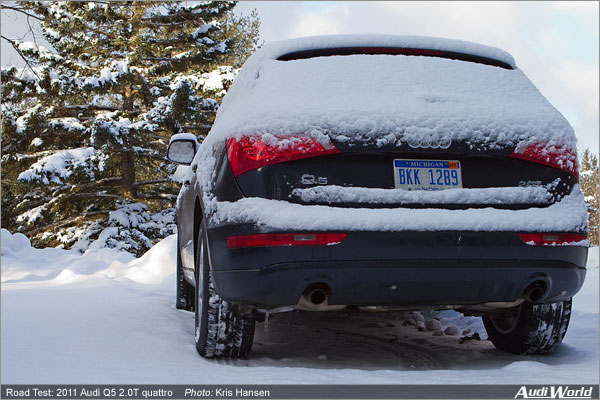
At higher engine speeds though, the turbocharger begins to lose efficiency, and the torque numbers drop. This is felt as a slightly less than eager acceleration above 5,000 rpm. This engine just doesnt have the strong pull at the top end that the 3.2 V6 has, but thats ok. With 8 ratios to play with in the new 8 speed Tiptronic transmission, Audi engineers are able to set gear spacing closer, allowing for brisk acceleration, and at the same time, have a nice long overdrive to keep the engine at low revs on the highway for maximum efficiency, and quiet running. Truth be told, in 8th gear on the interstate, its often advantageous to shift down to 6th to get the engine speeds up for hills and passing. But given the chance to cruise on a flat, 8th gear is just off idle for most of the time. Its very quiet, very calm. The 2.0T has no problem pulling off idle of course, but the fuel economy does suffer considerably when you ask it to.
While the 3.2 FSI V6 engine is not exactly a gas guzzler, the 2.0T is better when it comes to fuel consumption. Whereas the V6 engine version is EPA rated at 18 city 23 highway, the 2.0TI is rated at 20 and 27. We averaged 25mpg in mixed driving, which included photo shoots, back road play, and highway driving, in the winter, where fuel economy generally suffers due to extra idling and cold temperatures enriching the fuel mixture. For a vehicle like the Q5, we found that to be most excellent honestly.
Watching the instrument clusters instant fuel economy readout was interesting to say the least. There were times when a light foot, and 6th gear was showing us better mileage than 8th gear and a heavier foot to maintain speed. We also found that leaving the selector in D resulted in better average fuel economy and smoother driving than using the Tiptronic gate. Around town though, we liked using Tiptronic for keeping the engine in its maximum torque range.
Our test model was fairly basic when it came to options. It had no sunroof, no sat-nav, no power tailgate, none of the fancy things that are so nice to have, but arent 100% necessary. This kept the price WAY down. As tested, our Q5 cost under $39,000, which is amazing for what the basic car consists of. The base audio system is excellent. The interior is standard ultra high quality Audi. The dash, center console, and door panels are trimmed with wooden panels. The shifter knob and steering wheel are leather covered, as are the seats.
For whatever reason, our Q5 felt really light and nimble, and fun to drive. For a tall vehicle, cornering was relatively flat. This is a car that can be pushed a lot harder than seems obvious at first. Because of the great torque from the 2.0T, the Q5 pulls through the corner very well. Body roll is kept well in check too, and there is decent feel through the wheel. There were times when we were wishing for slightly softer spring rates from the suspension, such as on badly frost heaved roads. The ride was borderline firm at times. Its just not what we would describe as plush, by any means. It absorbs big bumps and expansion joints well enough, but for whatever reason, it didnt like frost heaves. Perhaps its due to the short wheelbase; or perhaps the cold weather made the oil in the shock absorbers more viscous and therefore increased the rates of damping. It wouldnt be a deal breaker for us, but we felt it was worth noting.
We also had the chance to drive the Q5 in some snow, which while not at all uncommon for our editors; we would mention that the car we drove was not fitted with snow tires. Nevertheless, the Q5 did extremely well negotiating some tough conditions with its all season tires. Thanks to Audis excellent ESP and traction control, what could have been hair raising moments were completely controlled in the Q5. Its times like those where the true nature of the car comes to the surface. The Q5 is a very stable platform, and it instills genuine confidence to its driver and passengers at all times. If you do manage to over-do it, the car works very hard to pull you back in from the brink of disaster, a fact that was hammered home nicely while we were busy forgetting that the car didnt have snow tires installed, and took a corner a bit too fast.
If someone demanded that we were to choose between the Q5 with the 2.0T and the 3.2, it would be a hard choice indeed. Both are wonderful cars, and have much to offer. We did leave the test with the impression that the 2.0T had a really great feel thanks to its abundant torque, which didnt require high revs or heavy foot to summon. Its perhaps a little louder than the V6 engine, but the Q5 has enough sound deadening where its really not an issue.
In terms of all out maximum performance, its a tough call. The 2.0T can do everything the 3.2 can do; it just costs a bit less. Tough call, but I think wed go for the 2.0T.
Resources: |

